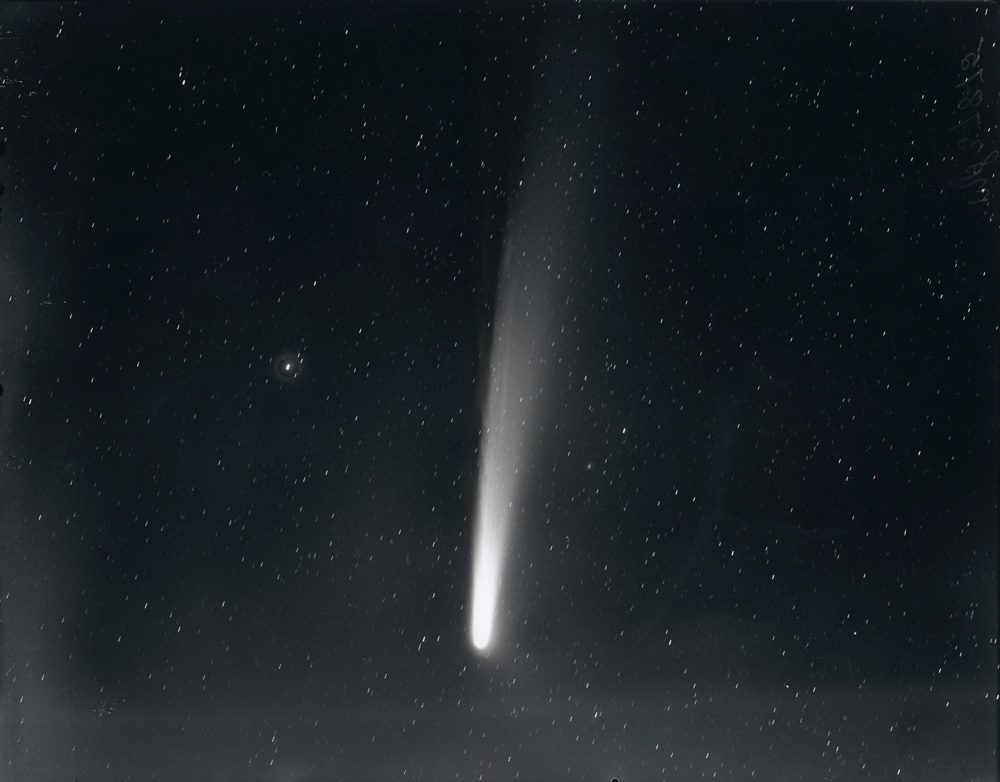
One of the most spectacular and awe-inspiring celestial sights is that of a bright, long-tailed comet – a “Great Comet,” the subject of a previous “Special Topics” presentation. On average, these appear about once a decade, and I have been privileged to have witnessed four of them during the half-century I have been observing comets – and to have been a co-discoverer of one of these – and there have been two others that have been visible from the southern hemisphere in recent years. The potential “Great Comet” ATLAS C/2019 Y4 (the “Comet of the Week” two weeks ago) has apparently disintegrated, and meanwhile it is conceivable that Comet NEOWISE C/2020 F3 (discussed within that same presentation) might reach such a status in July, but regardless of what happens with that object it is my hope that I along with the participating students and educators of “Ice and Stone 2020” might have a chance to witness this spectacular phenomenon sometime soon.
The appearances of bright comets are largely unpredictable, at least for long-period comets. With the comprehensive surveys that are operational these days an inbound bright long-period comet might be discovered a few years ahead of time – for example, Comet PANSTARRS C/2017 K2, which is a future “Comet of the Week” – but even at best this is only four or five years, and we still must contend with the fact that the long-term forecasting of comets’ brightnesses is rife with uncertainties. For known short-period comets, many of these issues disappear, but at the same time very few of these objects ever become bright enough to approach what might be considered a “Great Comet.” Comet 1P/Halley is, perhaps, the one notable exception to this, and indeed it has appeared “Great” on some returns, for example, as it did in 1910 and should in 2134; meanwhile, Comet 109P/Swift-Tuttle might achieve “Great Comet” status in 2126 and 2261. In any event, these future returns are a long time away, and any “Great Comets” that might appear in the lifetimes of those of us who are alive today will have to be long-period comets that – with the possible exceptions of NEOWISE C/2020 F3 and PANSTARRS C/2017 K2 – we don’t know about yet.
Another very spectacular and awe-inspiring sight is that of a total solar eclipse. During such an event – which takes place when the moon passes directly between the earth and the sun and completely covers up the sun – day is briefly turned into night (more like mid-twilight, although with some differences), the sun’s “corona,” or outer atmosphere, becomes visible, and some of the brighter stars and planets also become visible. The duration of totality is always very brief – usually two to four minutes, with a maximum possible duration of 7½ minutes – and totality itself is only visible along a long (perhaps 5000 km) but narrow (average 150 km) strip of Earth’s surface. In general, about seven to eight total eclipses occur each decade, and although this can vary widely, any given location on Earth’s surface should experience totality about once every 360 years, on the average. Unlike bright comets, the times and locations of total solar eclipses can be predicted centuries in advance, and thus if someone plans properly and is willing and able to travel, he/she can probably witness several total eclipses over the course of a lifetime (provided, of course, that the local weather cooperates). I have successfully observed eight total solar eclipses thus far during my lifetime.
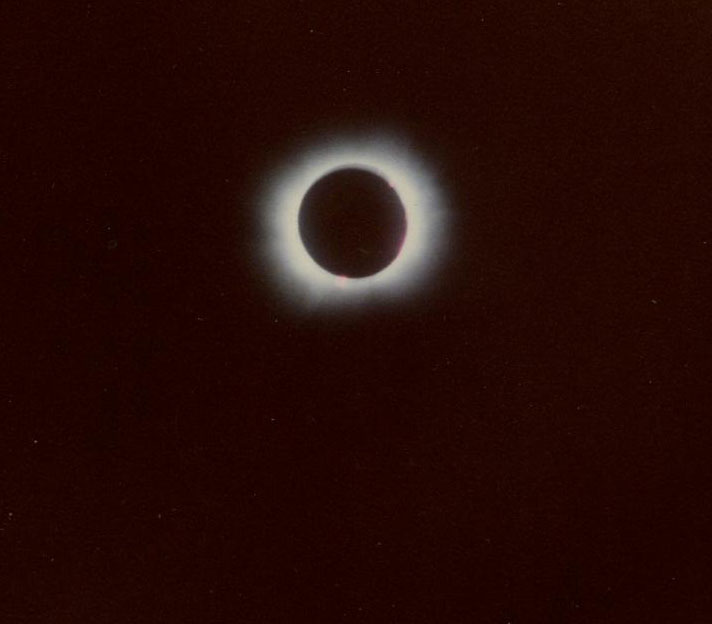
The combination of these two events, i.e., a bright comet appearing during a total solar eclipse, would thus be doubly spectacular, but on the other hand would be a very rare occurrence. Indeed, only a handful of such occurrences have been recorded throughout all of human history.
Since both comets and total solar eclipses were widely considered in ancient times to be mystical or supernatural phenomena, it can be difficult nowadays to assess the validity of reports from those times. The Greek philosopher Posidonius, who lived in the 1st and 2nd Centuries B.C., wrote of a comet that appeared during a solar eclipse, but whether or not he witnessed this event himself, and indeed what specific eclipse he might be referring to, are both unknown. (There are, unfortunately, no other contemporary accounts of any such comet.)
The Roman historian Philostorgius wrote that during the total eclipse that occurred on July 19, A.D. 418 – the path of which passed directly over Rome – an object that some people called a “comet” was visible. Both European and Chinese sources indicate that a comet appeared in June and July of that year, and Chinese references indicate a comet visible in September with a tail that apparently spanned 100 degrees, although it is unclear whether or not these reports all refer to the same comet or to different comets. In 1995 astronomer Gary Kronk successfully linked all the available data – such as it is – and was able to calculate an orbit, which indicates a perihelion passage in early October at a heliocentric distance of 0.35 AU. If this is indeed one comet (new style designation C/418 M1) and Kronk’s orbit is close to valid, then at the time of the eclipse it would have been located beyond the sun at heliocentric and geocentric distances of 1.72 and 2.35 AU, respectively. Although the comet does seem to have been a bright one intrinsically, it would have had to have been abnormally bright at these distances to have been noticed during a solar eclipse, and under the circumstances, it is difficult to reconcile the eclipse report with this particular comet.
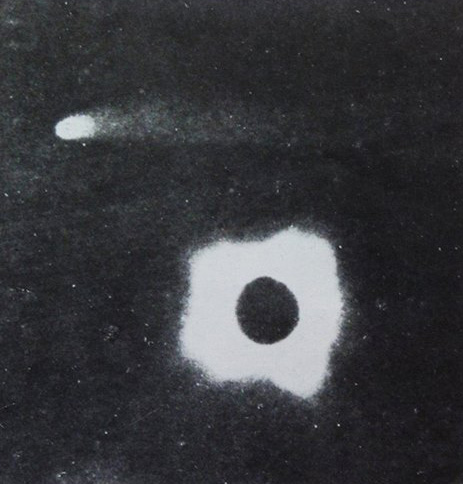
The first unequivocal detection of an eclipse comet was of Comet Tewfik X/1882 K1 during the total solar eclipse of May 17, 1882 – this week’s “Comet of the Week.” Although the limited data available does not permit the determination of an unambiguous orbit, Comet Tewfik was likely a Kreutz sungrazer, which are discussed in a future “Special Topics” presentation (and which, incidentally, provide the best chances for future eclipse comets).
On April 16, 1893 the path of a total solar eclipse crossed central South America and northwestern Africa. On examining detailed photographic plates he had taken of the eclipse from Chile, Lick Observatory astronomer Martin Schaeberle detected what appeared to be a possible comet extending out of the sun’s corona, and later found this same object on photographs taken by other expeditions to Brazil and Senegal. There were no reports of visual detections of this object, and meanwhile, in addition to exhibiting an arch-like shape atypical of comets, the available data indicates it moved rapidly away from the sun, and also faded dramatically, during the span of 2½ hours covered by the available photographs. A 1989 re-examination of the data by U.S. Air Force Geophysics Laboratory solar physicist Edward Cliver – by which time much more had been learned about physical and electromagnetic activity happening in and around the sun – concluded that this “comet” was likely a disconnected coronal mass ejection.
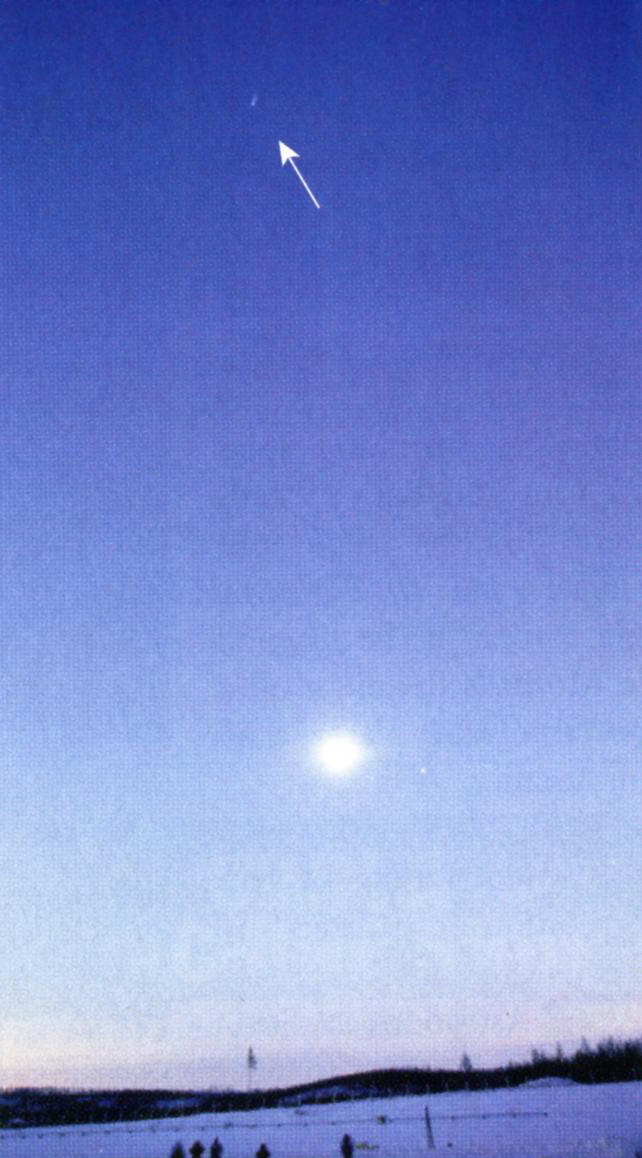
The next definite eclipse comet appeared during the total solar eclipse of November 1, 1948, most of the path of which crossed the Indian Ocean but which crossed east-central Africa shortly after sunrise (where the duration of totality was less than one minute). Observers on the ground near Nairobi, as well as those aboard a Royal Air Force plane flying at 4000 meters, detected a brilliant comet two degrees southwest of the eclipsed sun; it was apparently as bright as magnitude -3 and was reported as having a tail that stretched a considerable distance towards the horizon.
Within a few days this comet became visible in the dawn sky before sunrise, and by several days after that was widely seen from throughout the southern hemisphere as being between 1st and 2nd magnitude and with a relatively straight dust tail up to 20 degrees long. (The first reported post-eclipse sighting was made on November 4, by Captain Frank McGann of Pan American-Grace Airways while flying near Kingston, Jamaica; together with the R.A.F. detections during the eclipse, these would constitute the first comet discoveries made from an airplane.) The comet was never formally named but instead is referred to as the “Eclipse Comet of 1948;” designations are (old style) 1948l and 1948 XI, and (new style) C/1948 V1. Although it remained best visible from the southern hemisphere, the Eclipse Comet did become visible from the northern hemisphere during the second week of November – still at 2nd magnitude and with a tail almost 30 degrees long – and remained visible to the unaided eye until mid-December, with the final detections being made in April 1949.
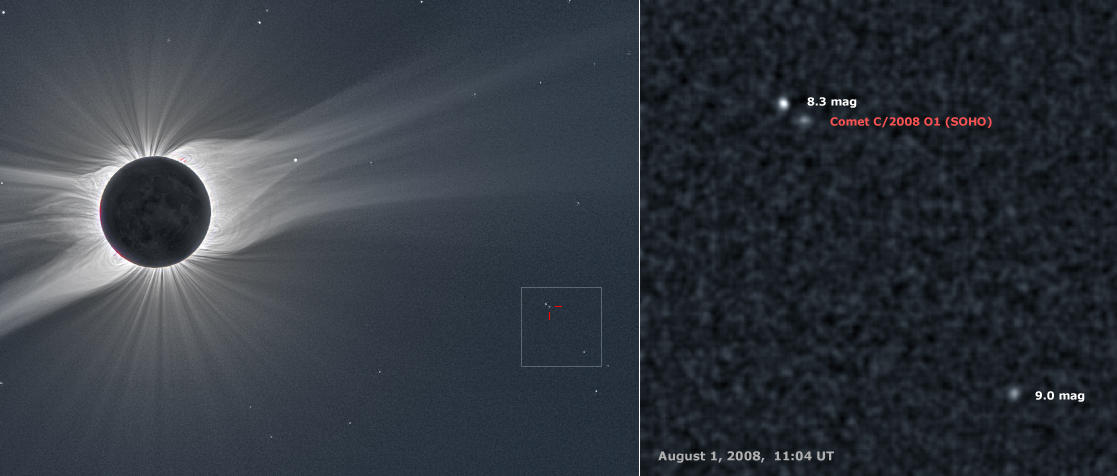
During recent decades several astronomers – myself being among them – have attempted searches for comets during total solar eclipses. During the eclipse on July 20, 1963, which crossed southern Alaska, central Canada, and the far northeastern continental U.S., NASA scientists Francois Dossin and Bert Donn reported their detection of an apparent faint comet on seven photographs taken for this purpose; they observed from central Maine, where the duration of totality was only one minute, and they also had to contend with clouds. Nothing else has been reported about this potential comet.
Eclipse-watchers who were willing to brave temperatures as cold as -25 C successfully observed Comet Hale-Bopp C/1995 O1 both visually and photographically during the total solar eclipse on March 9, 1997, which crossed eastern Siberia. The comet – a future “Comet of the Week” – was still over three weeks away from perihelion passage at the time, and was already as bright as magnitude 0 and exhibiting significant ion and dust tails.
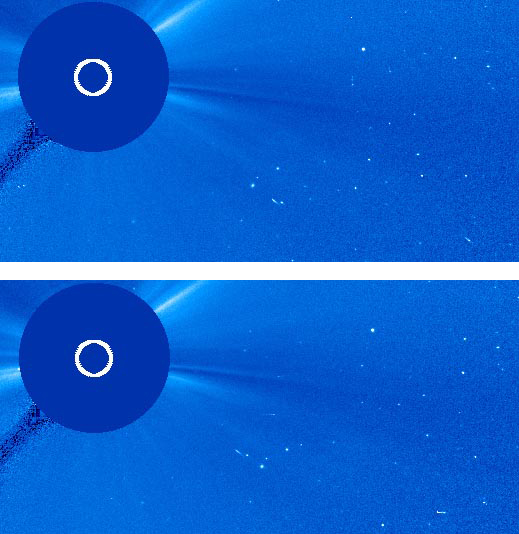
The large number of comets, and in particular Kreutz sungrazers, that have been detected in recent years with the LASCO coronagraphs aboard the NASA/ESA SOlar and Heliospheric Observatory (SOHO) spacecraft suggests that observations of these objects might be possible during total solar eclipses, and indeed I have attempted this during several recent eclipses, often in collaboration with SOHO-affiliated scientists. (These SOHO Kreutz sungrazers are discussed in a future “Comet of the Week” presentation, and any such detections would be very helpful in calibrating LASCO-determined brightnesses with ground-based observations.) Thus far my efforts have been unsuccessful, as the timing has to be almost perfect, i.e., a comet has to be near the sun, and moderately bright, at the precise time of totality. This apparently happened during the eclipse of August 1, 2008 – which I did not travel to – when a comet (C/2008 O1) was detected in LASCO C3 images roughly 20 hours before totality; while it was not detected visually, observers on the ground in Russia and in Mongolia detected it photographically as a relatively faint object of 8th or 9th magnitude.
The most recent total solar eclipse I have observed was the one on August 21, 2017, which I saw from Corvallis, Oregon. The vagaries of the timing issues involved are illustrated by the fact that, not one, but two, Kreutz sungrazers appeared in LASCO C3 images prior to the eclipse, but about 18 hours too early. By the time of totality these had already approached perihelion and had disintegrated.
I have not given up yet . . . Although, given the funding and logistical issues involved, I do need to be careful in deciding which eclipses I might travel to. Within the relatively near future, there is a total eclipse on this coming December 14, the path of which crosses southern Chile and the Patagonia region of south-central Argentina; this is a relatively short eclipse, with the maximum duration of totality barely exceeding two minutes. The path of totality for the December 4, 2021 eclipse crosses parts of Antarctica, and again this is a short eclipse, with a maximum duration of totality of less than two minutes. The logistics involved would make this an impractical eclipse to attempt to view, although it is perhaps worth pointing out that, during one portion of the path, totality will occur at local midnight.
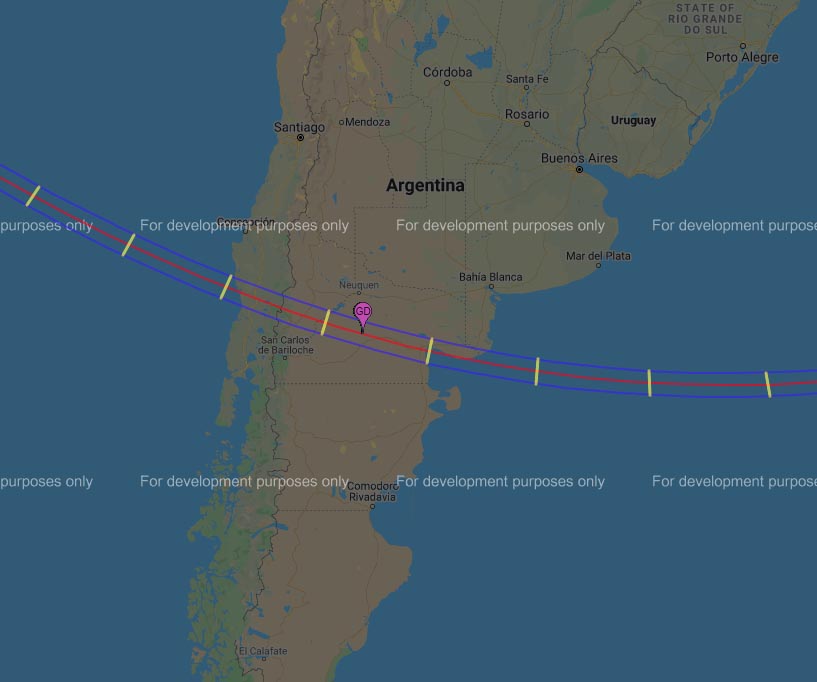
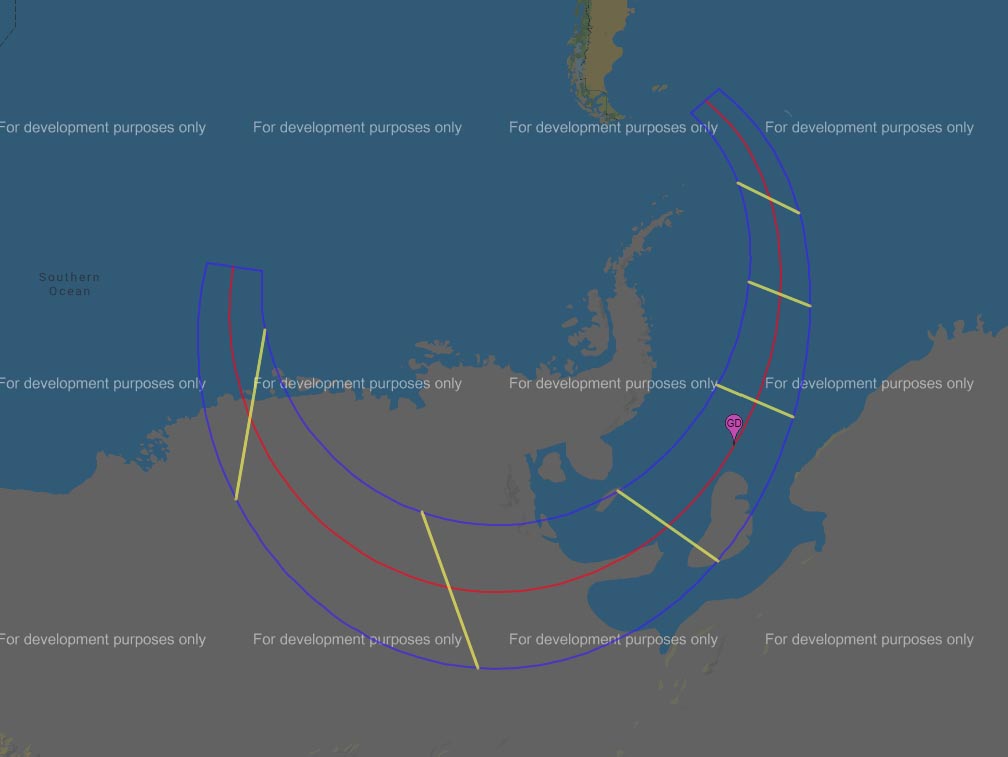
A “hybrid” eclipse, i.e., total in the middle of the path but annular at the extremities, takes place on April 20, 2023. The path mostly lies over water (the southern Indian Ocean and the southwestern Pacific Ocean) but does cross some of the islands in and around Indonesia (in particular, Timor-Leste and far western New Guinea); the North West Cape of Western Australia is also in the path. As is true for all hybrid eclipses, the duration of totality is very short, never being much above one minute in those portions of the path that cross land.
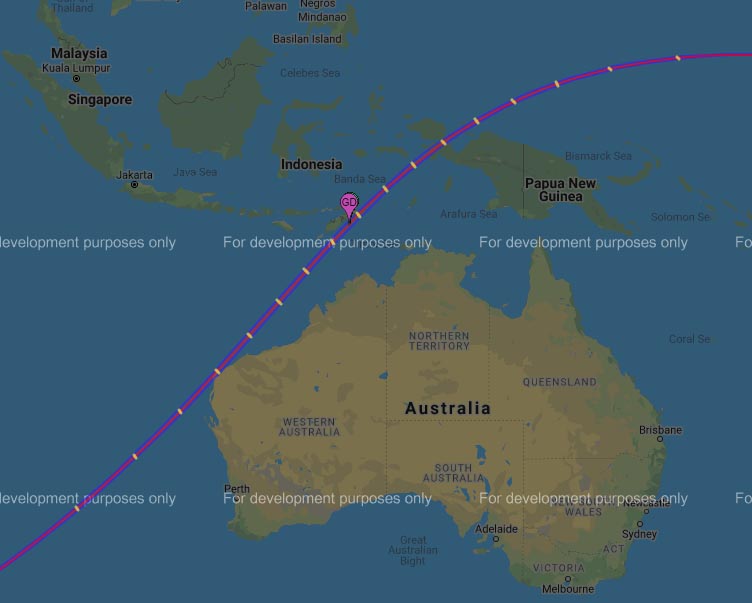
What would seem to be the best opportunity for observing a solar eclipse comet within the near-term future will come with the eclipse on April 8, 2024. The path of totality crosses northern Mexico, the south-central and northeastern U.S., and the Maritime Provinces of Canada. Mexico and Texas, which would also seem to have the best weather prospects, will experience a totality of almost 4½ minutes. I have already begun to make preliminary plans for this eclipse . . . Whether or not SOHO is still operational then remains to be seen, but presumably it and/or other follow-on missions (including STEREO-A, which is also operational at this time) will be able to provide advance notice if any Kreutz sungrazers, or any other comets for that matter, will be near the sun at the time of totality. In any event, given the state of detectors today it would seem unlikely that I or any future eclipse-watchers will ever again be surprised by the appearance of an unexpected comet during a total solar eclipse.
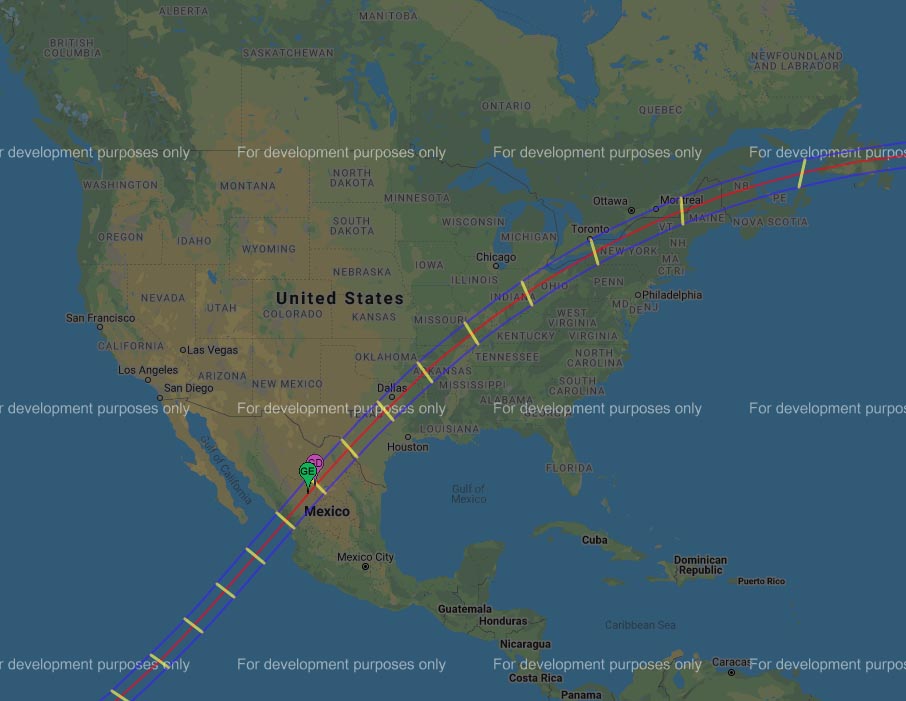
More from Week 21:
This Week in History Comet of the Week Free PDF Download Glossary
Ice and Stone 2020 Home Page


